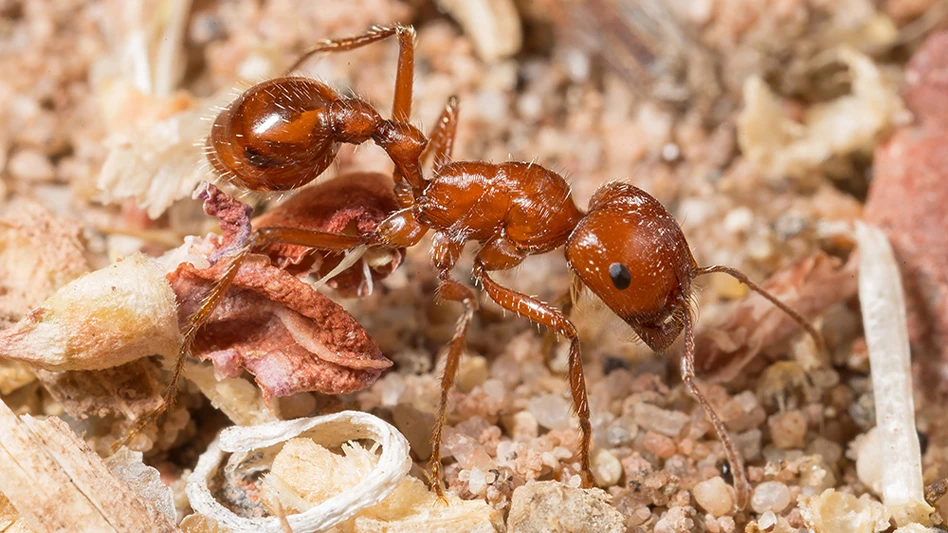
Derek Uhey
Editor’s Note: This article originally appeared in Entomology Today, a project of the Entomological Society of America with the goal of reporting interesting discoveries in the world of insect science and news from various entomological societies. To learn more, visit www.entomologytoday.org.
The reasons why some species are perceived as pests are often flawed. This is especially true for native species that play important roles in their ecosystems. Every entomologist knows the struggle of convincing someone of the importance of a maligned species or of convincing someone that social perceptions of a supposed pest are actually rubbish. No insect better exemplifies this than the harvester ant.
Harvester ants are common to most arid regions of the world. The name refers collectively to ants that harvest and consume seeds, primarily those in the genera Pogonomyrmex, Messor, and Veromessor. These ants collect a wide range of plant seeds and often construct large nests cleared of vegetation. Some species possess powerful stings, and most are opportunistic predators and scavengers. Through sheer abundance, harvester ants dominate many habitats, having enormous effects on associated ecosystems and human activities.
In November 2021 in the Annals of the Entomological Society of America, Richard Hofstetter, Ph.D., professor of forest entomology at Northern Arizona University, and I published a thorough review of research and knowledge about harvester ants, laying out the case for understanding them as keystone species rather than pests.
Harvester Ant Nests: ‘Islands of Fertility’
The true effect of harvester ants on landscapes is best seen from above. In some cases, the nest-clearings from ants account for over 15 percent of land area. Historically, this seemingly obvious reduction in vegetation did not sit well with some ranchers. In the western United States, ants were seen as enemies of range productivity. However, while ants clear vegetation on nest disks (the area immediately above and around a nest), vegetation flourishes along nest rims.
Along a harvester ant colony’s nest rim, plants benefit from access to increased nutrients deposited in the soil by the ants and from decreased competition thanks to the ant’s diligent clearing on the disk side. Once ecologists began measuring the growth of plants along ant nest rims, it became clear that the nest-rim vegetation more than made up for the cleared vegetation. More importantly, ecologists found that, following disturbances such as fire, grazing, and drought, nest rims become points of recovery for vegetation. Nest rims often host the first plants to grow back, and those go on to recolonize the rest of the landscape. Harvester ants are now known to be beneficial for creating these “islands of fertility.”
Biodiversity Hotspots
Not only are nests islands of fertility for vegetation, but they also provide a home for a wide range of organisms. “House guests” such as mites, silverfish, beetles, and springtails live alongside ants inside their nests, and soil biota such as bacteria, mycorrhizae, and protists are abundant in ant nest soils. An assortment of beetles and other arthropods scavenge from harvester ant “trash dumps,” where ants pile their refuse; these often contain discarded seeds and are nutrient rich environments. Nests therefore become biodiversity hotspots, hosting dozens or even hundreds of species that all play a part in recycling nutrients and energy within the ecosystem.
Harvester ants themselves play important roles in food chains as both predators and prey. Opportunistic and armed with powerful mandibles, anything the ants can overpower is a potential source of food (in addition to seeds, of course!). Meanwhile, for many other arthropods, birds, lizards, and small mammals, harvester ant workers are an abundant food source. Some species of horned lizards are entirely dependent on harvester ants as a source of food. Harvester ants are also an important food source for the endangered sage grouse—which, incidentally, also likes to climb on top of ant mounds when it dances for mates!
Manageable Threats
Harvester ants are awesome, but might they potentially pose a threat to seed crops from which they could harvest seeds for themselves? Well, once again ecologists have flipped that perceived pest narrative through careful research. Many studies show that harvester ants actually prefer seeds of weedy species, rather than crop species we humans are interested in. Ants take few if any of the desired crop species, but they do help suppress weeds.
Ants, however, may take seeds used in ecological restoration, hampering some broadcast seeding efforts relying on dropping of seed on ground surfaces. Yet simple efforts such as choosing seed species the ants do not like to harvest or applying seeds when ants are not active can help address the problem and avoid unnecessary seed loss from ants during restoration efforts.
Some species of harvester ants do possess powerful stings, which certainly have contributed to their perceived negative image. In fact, the most venomous insect known is the Maricopa harvester ant (Pogonomyrmex maricopa). Getting stung is not something you’ll soon forget. Similar to many wasps and bees, the sting is painful but usually causes little physical damage, and the venom injected by a sting is an extremely small amount. In rare cases, ant stings can be dangerous for individuals with an allergic reaction causing anaphylaxis or if individuals cannot remove themselves from nest areas and become swarmed. But, fortunately, harvester ant stings are relatively easy to avoid as they do not fly and rarely enter homes.
Keystone Species
Latest from Pest Control Technology
- Donny Oswalt Shares What Makes Termites a 'Tricky' Pest
- Study Finds Fecal Tests Can Reveal Active Termite Infestations
- Peachtree Pest Control Partners with Local Nonprofits to Fight Food Insecurity
- Allergy Technologies, PHA Expand ATAHC Complete Program to Protect 8,500 Homes
- Housecall Pro Hosts '25 Winter Summit Featuring Mike Rowe
- Advanced Education
- Spotted Lanternflies, BMSBs Most Problematic Invasive Pests, Poll Finds
- Ecolab Acquires Guardian Pest Solutions





